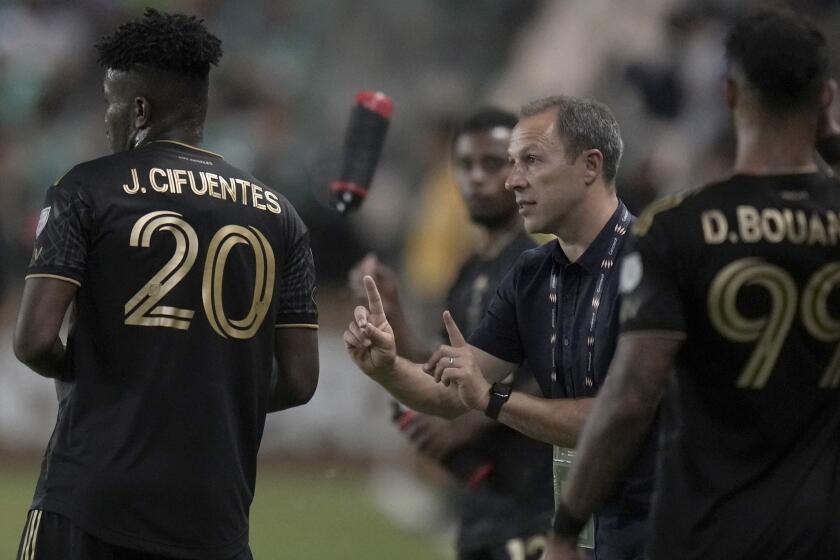OAK TREE : Good Times Here for Corey Black, and He Is Enjoying Them to Fullest
- Share via
Corey Black has spent the last several days accepting handshakes and high-fives from the local racing colony after his victory aboard Jack Kent Cooke’s Flying Continental in the Jockey Club Gold Cup last Saturday at Belmont Park.
With its purse of $838,500, the Gold Cup was the richest victory of Black’s career, as well as his first score in New York. More significant, however, Flying Continental appears to be peaking at the perfect time. The Gold Cup preceded the Breeders’ Cup Classic by exactly three weeks, which gives Black high hopes for a major payday in that $3-million event.
“He won at the same track, the same distance and carried the same weight as in the Classic,” Black said after returning to Santa Anita this week. “On top of that, I’ve got every reason to believe he can improve off that race. And if it comes up rain, well, shame on them. You know what a freak he is in the mud.”
That’s typical Corey Black, never known to be shy, soft-spoken or reticent. But the Orange County native has earned his air time. Unike so many other 21-year-old jockeys who are scuffling around the Southern California circuit, desperate for any sort of horse, Black is holding his own in direct competition with hard-bitten veterans for the choicest mounts around.
Flying Continental has helped Black to his best season. Through last weekend, his horses had earned more than $4.2 million, which puts him in the top 20 nationwide. Furthermore, his stakes winnings have kept him in the top 10 for most of 1990.
Besides Flying Continental, who also took the Strub and San Fernando Stakes earlier this year, Black has been the regular rider for Petite Ile, the leading candidate for champion turf female. When asked to describe the Irish-bred filly, Black was, for once, momentarily speechless.
“She’s . . . She’s just . . . Put it this way: There’s good horses, and then there’s Petite Iles and Sunday Silences.”
Black has ridden Petite Ile to four stakes victories this year, two of them against males. A minor leg injury knocked her out of the Del Mar Handicap and the Oak Tree Invitational, but trainer Eddie Gregson has her back on target for the Yellow Ribbon Stakes at Santa Anita on Nov. 4.
“Some things are just meant to be,” Black said. “The Gold Cup and the Oak Tree were on the same day, and I would have had to choose between Flying Continental and Petite Ile.”
As the son of a former quarter horse rider, Black was a true race track brat. He ran loose in the box seats as a grade schooler, ingratiating himself with bemused legends who got used to Black’s piccolo voice piping up things such as, “Hi, Mr. Barrera! Hi, Mr. Whittingham! I like your horse in the feature today!”
By the time he was old enough to ride professionally, Black had accumulated a wellspring of backstretch savvy. He knew who got the best horses and why, and he aligned himself with trainers who were not turned off by a 17-year-old know-it-all. In fact, Black knew a lot.
Charlie Whittingham once said: “I’ve got to admit, he knows his horses. And just about everyone else’s, too.”
After a precocious apprenticeship, Black went through the usual withdrawal period when he lost his five-pound weight allowance. But he was not afraid to experiment with his skills. He tried riding at Longacres in Seattle, then took a contract with the up-and-coming French trainer, Andre Fabre, in France.
The French experience sealed Black’s fate. He came home in the summer of 1987 with a riding style shaped by the European racing game, where the pace is rarely hurried and the tactics of the jockey are paramount. Back home at Hollywood Park and Del Mar, he was faced with the same old go-go game and programs full of cheap horses and cheap races. Break, hustle, whip it and stagger home.
Black is the first to admit that he had become a very un-California rider. As a result, his overall business suffered in terms of volume, even though he was, until this year, the perennial leader at the hyper-competitive Fairplex Park meetings.
Black has ridden barely 700 horses this year, compared to more than 1,000 for many of his contemporaries. He makes up the difference by maintaining a core of loyal patrons--trainers such as Gregson and Julio Canani--who use Black for a number of their best runners.
“He’s the exact opposite of most young riders,” Gregson said. “Stakes races never make him nervous. As long as he’s that way, he’ll be around a long time.”
Black would prefer to be pegged as an all-around rider. Yet his idols are the retired Bill Shoemaker and Fernando Toro, who were known for their big-race records more than their day-to-day output.
“I’d love to ride eight horses a day,” Black said. “I’m young and willing to do it. But there’s a difference between riding a good horse and a cheap horse. In fact, I’d say it’s almost impossible to ride a good race on a cheap horse.”
More to Read
Go beyond the scoreboard
Get the latest on L.A.'s teams in the daily Sports Report newsletter.
You may occasionally receive promotional content from the Los Angeles Times.










